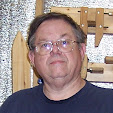on the modules on Wednesday morning. I touched up ground cover here and there, then
added scrub bushes wherever they looked okay to me, a few trees here and there, and some
flowers.
 These are a new item from Noch, and I like the way they look. In the picture, they are the row of five white ones and two yellow ones. There are some red ones in the set, too. I used some of them on another module.
These are a new item from Noch, and I like the way they look. In the picture, they are the row of five white ones and two yellow ones. There are some red ones in the set, too. I used some of them on another module. They may be a bit small in HO and larger scales, but they are a nice size for N.
Once this was done, I started the thing I hate most in model railroading ... sealing with water and white glue mixture. I'm very messy, and I feel that I'm ruining everything I've been working on. I know from past experiences that all will be okay, but still that's the feelings I have while doing it.
I sealed five modules today, four N and one HO. There are two more HO modules to do
tomorrow. Once all are done, I'll wind up the proceedings by attaching the track and
wiring (where needed.)
 The HO module stack shows the four club single-length straights. They are stored and transported in two Payne frames, two per frame. The upper two modules are tomorrow's victims, uh, subjects.
The HO module stack shows the four club single-length straights. They are stored and transported in two Payne frames, two per frame. The upper two modules are tomorrow's victims, uh, subjects. The third from the top was the one sealed today. The bottom module is being worked on by Jan K. whenever she has time. She's also doing a couple of other modules, so she isn't missing this one right now.
 The N stack has the other four modules sealed today. Like the HO modules, there are two of these double-length modules per Payne frame.
The N stack has the other four modules sealed today. Like the HO modules, there are two of these double-length modules per Payne frame. On top of the frames sits the junction module. I tried a couple of different ideas for the center depression. I didn't like them, so I did it like it is a dry gulch/lake bed ares, overgrown in grass and scrub bushes.
The junction and the next three frames below it were all treated today.
The bottom module was finished some time back. It is the one that was in the Plano show as a visitor, courtesy of the North Texas T-Trak Group.
Once the last two are sealed tomorrow, it's track time, and the smaller structures (that will fit while sliding the modules in and out of the frames) will be glued down.
If you're not familiar with these frames, they were inspired by a similar item made by Don Payne, hence Payne frames. I make mine 18" high, and usually place the upper module support in the middle, vertically. In some cases, however, I have offset the placement of the support to allow for a taller module above it while having a lower-profile module below. Except for this one fact, all slots are pretty much interchangeable, not module specific.
Why 18" high? That's the clearance under the solid tonneau cover on my pickup bed.
And, I'm going to add a thin sheet of cardboard (from a refrigerator box, for example) to the bottom of each frame position. This won't affect the capacity of the frames at all, but will keep wires dangling underneath from snagging on anything else.
To go to a show, I just slide the frames in the pickup bed, along with a dolly. They make it easy to transport a number of modules. In fact, the frames for the single-length straights and the corners hold four modules. So, they are about the same size as the double-length frames. The four frames fit on the dolly, carrying 12 modules at once.
If there's time, there's also two new 6-foot N modules that need me do something. They may have to be run with just bare paint, but I really hate that. I think I'd rather not show them at all. Their purpose it to be a long interconnect between my TTrak-N lop of modules and those of Allen's. We'll see if they make it to the show or not.




















 Here is building set B (I also have set A) and a pier. Each pier will hold two stores, and there are four stores in a set. The pier I selected is the 'small' pier, meaning it is a few mm shorter than the 'large' pier.
Here is building set B (I also have set A) and a pier. Each pier will hold two stores, and there are four stores in a set. The pier I selected is the 'small' pier, meaning it is a few mm shorter than the 'large' pier. 














 Okay, now for the Kato part. First, remove the Unijoiners from the track piece. You will save them for later, right? Carefully examine the base of the rails at each end of the section. On one end, there are small 'dimples' in the rail flange that lock the rails to the roadbed. I call this the 'locked' end. The other end I call the 'loose' end.
Okay, now for the Kato part. First, remove the Unijoiners from the track piece. You will save them for later, right? Carefully examine the base of the rails at each end of the section. On one end, there are small 'dimples' in the rail flange that lock the rails to the roadbed. I call this the 'locked' end. The other end I call the 'loose' end.











